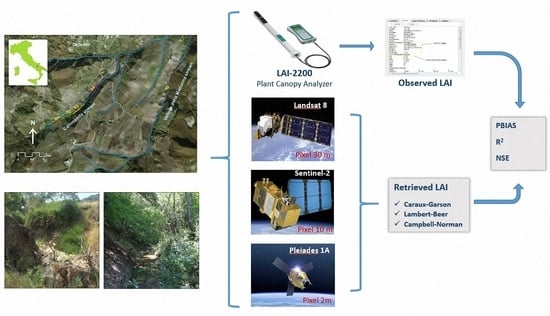Influence of Different Satellite Imagery on the Analysis of Riparian Leaf Density in a Mountain Stream
Abstract
1. Introduction
2. Materials and Methods
2.1. Study Area
2.2. Field Data and Satellite Imagery
2.3. LAI Calculation
3. Results
4. Discussion
5. Conclusions
Author Contributions
Funding
Acknowledgments
Conflicts of Interest
References
- Horning, N. Remote Sensing. In Encyclopedia of Ecology; Elsevier: Amsterdam, The Netherlands, 2008. [Google Scholar]
- Slonecker, E.T.; Jennings, D.B.; Garofalo, D. Remote sensing of impervious surfaces: A review. Remote Sens. Rev. 2001, 20, 227–255. [Google Scholar] [CrossRef]
- Balsamo, G.; Agusti-Panareda, A.; Albergel, C.; Arduini, G.; Beljaars, A.; Bidlot, J.; Blyth, E.; Bousserez, N.; Boussetta, S.; Brown, A.; et al. Satellite and In Situ Observations for Advancing Global Earth Surface Modelling: A Review. Remote Sens. 2018, 10, 2038. [Google Scholar] [CrossRef]
- Schowengerdt, R.A. Remote Sensing; Elsevier: Amsterdam, The Netherlands, 2007; ISBN 9780123694072. [Google Scholar]
- Salamí, E.; Barrado, C.; Pastor, E. UAV Flight Experiments Applied to the Remote Sensing of Vegetated Areas. Remote Sens. 2014, 6, 11051–11081. [Google Scholar] [CrossRef]
- Räsänen, A.; Virtanen, T. Data and resolution requirements in mapping vegetation in spatially heterogeneous landscapes. Remote Sens. Environ. 2019, 230, 111207. [Google Scholar] [CrossRef]
- Yao, H.; Qin, R.; Chen, X. Unmanned Aerial Vehicle for Remote Sensing Applications—A Review. Remote Sens. 2019, 11, 1443. [Google Scholar] [CrossRef]
- Calsamiglia, A.; Gago, J.; Garcia-Comendador, J.; Bernat, J.F.; Calvo-Cases, A.; Estrany, J. Evaluating functional connectivity in a small agricultural catchment under contrasting flood events by using UAV. Earth Surf. Process. Landf. 2020, 45, 800–815. [Google Scholar] [CrossRef]
- Matese, A.; Toscano, P.; Di Gennaro, S.; Genesio, L.; Vaccari, F.; Primicerio, J.; Belli, C.; Zaldei, A.; Bianconi, R.; Gioli, B. Intercomparison of UAV, Aircraft and Satellite Remote Sensing Platforms for Precision Viticulture. Remote Sens. 2015, 7, 2971–2990. [Google Scholar] [CrossRef]
- Chen, Y.; Guerschman, J.P.; Cheng, Z.; Guo, L. Remote sensing for vegetation monitoring in carbon capture storage regions: A review. Appl. Energy 2019, 240, 312–326. [Google Scholar] [CrossRef]
- Xue, J.; Su, B. Significant remote sensing vegetation indices: A review of developments and applications. J. Sens. 2017, 2017, 1353691. [Google Scholar] [CrossRef]
- Romano, G.; Ricci, G.F.; Gentile, F. Comparing LAI Field Measurements and Remote Sensing to Assess the Influence of Check Dams on Riparian Vegetation Cover. In Lecture Notes in Civil Engineering; Coppola, A., Di Renzo, G., Altieri, G., D’Antonio, P., Eds.; Springer: Berlin, Germany, 2020; Volume 67, pp. 109–116. [Google Scholar]
- Liang, S.; Wang, J. Advanced Remote Sensing Terrestrial Information Extraction and Applications, 2nd ed.; Elsevier: Amsterdam, The Netherlands, 2020. [Google Scholar]
- Vorovencii, L. Satellite Remote Sensing in Environmental Impact Assessment: An Overview. Bull. Transilv. Univ. Braşov 2011, 4, 1–8. [Google Scholar]
- Toth, C.; Jóźków, G. Remote sensing platforms and sensors: A survey. ISPRS J. Photogramm. Remote Sens. 2016, 115, 22–36. [Google Scholar] [CrossRef]
- Piermattei, L.; Marty, M.; Karel, W.; Ressl, C.; Hollaus, M.; Ginzler, C.; Pfeifer, N. Impact of the Acquisition Geometry of Very High-Resolution Pléiades Imagery on the Accuracy of Canopy Height Models over Forested Alpine Regions. Remote Sens. 2018, 10, 1542. [Google Scholar] [CrossRef]
- Johansen, K.; Coops, N.C.; Gergel, S.E.; Stange, Y. Application of high spatial resolution satellite imagery for riparian and forest ecosystem classification. Remote Sens. Environ. 2007, 110, 29–44. [Google Scholar] [CrossRef]
- Lopez, R.R.D.; Frohn, R.C. Remote Sensing for Landscape Ecology: New Metric Indicators: Monitoring, Modeling, and Assessment of Ecosystems, 2nd ed.; CRC Press: Boca Raton, FL, USA, 2017; ISBN 9781498754392. [Google Scholar]
- Lu, D. The potential and challenge of remote sensing-based biomass estimation. Int. J. Remote Sens. 2006, 27, 1297–1328. [Google Scholar] [CrossRef]
- Lu, D.; Chen, Q.; Wang, G.; Liu, L.; Li, G.; Moran, E. A survey of remote sensing-based aboveground biomass estimation methods in forest ecosystems. Int. J. Digit. Earth 2016, 9, 63–105. [Google Scholar] [CrossRef]
- Chen, J.M.; Black, T.A. Defining leaf area index for non-flat leaves. Plant. Cell Environ. 1992, 15, 421–429. [Google Scholar] [CrossRef]
- Nagler, P.L.; Glenn, E.P.; Huete, A.R. Assessment of spectral vegetation indices for riparian vegetation in the Colorado River delta, Mexico. J. Arid Environ. 2001, 49, 91–110. [Google Scholar] [CrossRef]
- Pierce, L.L.; Running, S.W. Rapid estimation of coniferous forest leaf area index using a portable integrating radiometer. Ecology 1988, 69, 1762–1767. [Google Scholar] [CrossRef]
- Fang, H.; Liang, S. Leaf Area Index Models. In Reference Module in Earth Systems and Environmental Sciences; Elsevier: Amsterdam, The Netherlands, 2014. [Google Scholar]
- McMichael, C.E.; Hope, A.S.; Roberts, D.A.; Anaya, M.R. Post-fire recovery of leaf area index in California chaparral: A remote sensing-chronosequence approach. Int. J. Remote Sens. 2004, 25, 4743–4760. [Google Scholar] [CrossRef]
- Chapin, F.S.; Eviner, V.T. Biogeochemistry of Terrestrial Net Primary Production. In Treatise on Geochemistry; Elsevier: Amsterdam, The Netherlands, 2007; Volumes 8–9, pp. 1–35. ISBN 9780080548074. [Google Scholar]
- Ricci, G.F.; Romano, G.; Leronni, V.; Gentile, F. Effect of check dams on riparian vegetation cover: A multiscale approach based on field measurements and satellite images for Leaf Area Index assessment. Sci. Total Environ. 2019, 657, 827–838. [Google Scholar] [CrossRef]
- Richards, D.; Wang, J.W. Fusing street level photographs and satellite remote sensing to map leaf area index. Ecol. Indic. 2020, 115. [Google Scholar] [CrossRef]
- Wang, Q.; Adiku, S.; Tenhunen, J.; Granier, A. On the relationship of NDVI with leaf area index in a deciduous forest site. Remote Sens. Environ. 2005, 94, 244–255. [Google Scholar] [CrossRef]
- Sripada, R.P.; Heiniger, R.W.; White, J.G.; Weisz, R. Aerial Color Infrared Photography for Determining Late-Season Nitrogen Requirements in Corn. Reprod. Agron. J. 2005, 98, 968–977. [Google Scholar] [CrossRef]
- Milella, P.; Bisantino, T.; Gentile, F.; Iacobellis, V.; Trisorio Liuzzi, G. Diagnostic analysis of distributed input and parameter datasets in Mediterranean basin streamflow modeling. J. Hydrol. 2012, 472–473, 262–276. [Google Scholar] [CrossRef]
- Sinha, S.K.; Padalia, H.; Dasgupta, A.; Verrelst, J.; Rivera, J.P. Estimation of leaf area index using PROSAIL based LUT inversion, MLRA-GPR and empirical models: Case study of tropical deciduous forest plantation, North India. Int. J. Appl. Earth Obs. Geoinf. 2020, 86, 102027. [Google Scholar] [CrossRef]
- Xavier, A.C.; Vettorazzi, C.A. Mapping leaf area index through spectral vegetation indices in a subtropical watershed. Int. J. Remote Sens. 2004, 25, 1661–1672. [Google Scholar] [CrossRef]
- Malanson, G.P. Riparian Landscapes; Cambridge University Press: Cambridge, UK, 1993. [Google Scholar]
- Hancock, C.N.; Ladd, P.G.; Froend, R.H. Biodiversity and management of riparian vegetation in western Australia. For. Ecol. Manag. 1996, 85, 239–250. [Google Scholar] [CrossRef]
- Inoue, M.; Nakagoshi, N. The effects of human impact on spatial structure of the riparian vegetation along the Ashida river, Japan. Landsc. Urban Plan. 2001, 53, 111–121. [Google Scholar] [CrossRef]
- Fu, B.; Li, Y.; Wang, Y.; Zhang, B.; Yin, S.; Zhu, H.; Xing, Z. Evaluation of ecosystem service value of riparian zone using land use data from 1986 to 2012. Ecol. Indic. 2016, 69, 873–881. [Google Scholar] [CrossRef]
- Bombino, G.; Boix-Fayos, C.; Gurnell, A.M.; Tamburino, V.; Zema, D.A.; Zimbone, S.M. Check dam influence on vegetation species diversity in mountain torrents of the Mediterranean environment. Ecohydrology 2014, 7, 678–691. [Google Scholar] [CrossRef]
- Zema, D.A.; Bombino, G.; Denisi, P.; Lucas-Borja, M.E.; Zimbone, S.M. Evaluating the effects of check dams on channel geometry, bed sediment size and riparian vegetation in Mediterranean mountain torrents. Sci. Total Environ. 2018, 642, 327–340. [Google Scholar] [CrossRef]
- Vigiak, O.; Malagó, A.; Bouraoui, F.; Grizzetti, B.; Weissteiner, C.J.; Pastori, M. Impact of current riparian land on sediment retention in the Danube River Basin. Sustain. Water Qual. Ecol. 2016, 8, 30–49. [Google Scholar] [CrossRef]
- European Commission Directive 2000/60/EC. Official Journal of the European Communities. 2000. Available online: https://eur-lex.europa.eu/legal-content/EN/TXT/?uri=celex:32000L0060 (accessed on 8 September 2020).
- Stella, J.C.; Rodríguez-González, P.M.; Dufour, S.; Bendix, J. Riparian vegetation research in Mediterranean-climate regions: Common patterns, ecological processes, and considerations for management. Hydrobiologia 2013, 719, 291–315. [Google Scholar] [CrossRef]
- Clerici, N.; Weissteiner, C.J.; Paracchini, M.L.; Boschetti, L.; Baraldi, A.; Strobl, P. Pan-European distribution modelling of stream riparian zones based on multi-source Earth Observation data. Ecol. Indic. 2013, 24, 211–223. [Google Scholar] [CrossRef]
- LI-COR LI-2200C Plant Canopy Analyzer. 2010. Available online: https://licor.app.boxenterprise.net/s/fqjn5mlu8c1a7zir5qel (accessed on 8 September 2020).
- Abdelwahab, O.M.M.; Bingner, R.L.; Milillo, F.; Gentile, F. Evaluation of Alternative Management Practices with the AnnAGNPS Model in the Carapelle Watershed. Soil Sci. 2016, 181, 293–305. [Google Scholar] [CrossRef]
- Bisantino, T.; Gentile, F.; Milella, P.; Liuzzi, G.T. Effect of Time Scale on the Performance of Different Sediment Transport Formulas in a Semiarid Region. J. Hydraul. Eng. 2010, 136, 56–61. [Google Scholar] [CrossRef]
- Ricci, G.F.; De Girolamo, A.M.; Abdelwahab, O.M.M.; Gentile, F. Identifying sediment source areas in a Mediterranean watershed using the SWAT model. Land Degrad. Dev. 2018, 29, 1233–1248. [Google Scholar] [CrossRef]
- Aquilino, M.; Novelli, A.; Tarantino, E.; Iacobellis, V.; Gentile, F. Evaluating the Potential of GeoEye Data in Retrieving LAI at Watershed Scale. In Remote Sensing for Agriculture, Ecosystems, and Hydrology XVI, Proceedings of the SPIE Remote Sensing, Amsterdam, The Netherlands, 22–25 September 2014; Neale, C.M.U., Maltese, A., Eds.; SPIE: Paris, France, 2014; Volume 9239, p. 92392B. [Google Scholar]
- Yan, G.; Hu, R.; Luo, J.; Weiss, M.; Jiang, H.; Mu, X.; Xie, D.; Zhang, W. Review of indirect optical measurements of leaf area index: Recent advances, challenges, and perspectives. Agric. For. Meteorol. 2019, 265, 390–411. [Google Scholar] [CrossRef]
- Riihimäki, H.; Luoto, M.; Heiskanen, J. Estimating fractional cover of tundra vegetation at multiple scales using unmanned aerial systems and optical satellite data. Remote Sens. Environ. 2019, 224, 119–132. [Google Scholar] [CrossRef]
- Mihai, B.A.; Săvulescu, I.; Vîrghileanu, M.; Olariu, B. Evaluation of sentinel-2 MSI and pleiades 1B imagery in forest fire susceptibility assessment in temperate regions of Central and Eastern Europe. A Case study of Romania. In Advances in Natural and Technological Hazards Research; Springer: Rotterdam, The Netherlands, 2019; Volume 48, pp. 253–269. [Google Scholar]
- Pu, R.; Landry, S. Evaluating seasonal effect on forest leaf area index mapping using multi-seasonal high resolution satellite pléiades imagery. Int. J. Appl. Earth Obs. Geoinf. 2019, 80, 268–279. [Google Scholar] [CrossRef]
- Wang, D.; Wan, B.; Qiu, P.; Su, Y.; Guo, Q.; Wang, R.; Sun, F.; Wu, X. Evaluating the Performance of Sentinel-2, Landsat 8 and Pléiades-1 in Mapping Mangrove Extent and Species. Remote Sens. 2018, 10, 1468. [Google Scholar] [CrossRef]
- Chander, G.; Markham, B.L.; Helder, D.L. Summary of current radiometric calibration coefficients for Landsat MSS, TM, ETM+, and EO-1 ALI sensors. Remote Sens. Environ. 2009, 113, 893–903. [Google Scholar] [CrossRef]
- Romano, G.; Abdelwahab, O.M.M.; Gentile, F. Modeling land use changes and their impact on sediment load in a Mediterranean watershed. Catena 2018, 163, 342–353. [Google Scholar] [CrossRef]
- Vanhellemont, Q.; Ruddick, K. Atmospheric correction of metre-scale optical satellite data for inland and coastal water applications. Remote Sens. Environ. 2018, 216, 586–597. [Google Scholar] [CrossRef]
- Zhan, Z.-Z.; Liu, H.-B.; Li, H.-M.; Wu, W.; Zhong, B. The Relationship between NDVI and Terrain Factors—A Case Study of Chongqing. Procedia Environ. Sci. 2012, 12, 765–771. [Google Scholar] [CrossRef]
- Ayalew, D.A.; Deumlich, D.; Šarapatka, B.; Doktor, D. Quantifying the Sensitivity of NDVI-Based C Factor Estimation and Potential Soil Erosion Prediction using Spaceborne Earth Observation Data. Remote Sens. 2020, 12, 1136. [Google Scholar] [CrossRef]
- Rouse, J.W.J.; Haas, R.; Schell, J.; Deering, D.; Harlan, J.C. Monitoring the Vernal Advancement and Retrogradation (Green Wave Effect) of Natural Vegetation. Available online: https://ntrs.nasa.gov/citations/19740008955 (accessed on 12 September 2020).
- Nemani, R.; Pierce, L.; Running, S.; Band, L. Forest ecosystem processes at the watershed scale: Sensitivity to remotely-sensed leaf area index estimates. Int. J. Remote Sens. 1993, 14, 2519–2534. [Google Scholar] [CrossRef]
- Sibanda, M.; Mutanga, O.; Rouget, M. Examining the potential of Sentinel-2 MSI spectral resolution in quantifying above ground biomass across different fertilizer treatments. ISPRS J. Photogramm. Remote Sens. 2015, 110, 55–65. [Google Scholar] [CrossRef]
- Cahalane, C.; Magee, A.; Monteys, X.; Casal, G.; Hanafin, J.; Harris, P. A comparison of Landsat 8, RapidEye and Pleiades products for improving empirical predictions of satellite-derived bathymetry. Remote Sens. Environ. 2019, 233, 111414. [Google Scholar] [CrossRef]
- Caraux-Garson, D.; Lacaze, B.; Scala, F.; Hill, J.; Mehel, W. Ten years of vegetation cover monitoring with Landsat TM remote sensing, an operational approach of DeMon-2 in Languedoc, France. In Proceedings of the 18th EARSeL Symposium on Operational Remote Sensing for Sustainable Development, Enschede, The Netherlands, 11–14 May 1998. [Google Scholar]
- Lacaze, B. Integrated Approaches to Desertification Mapping and Monitoring in the Mediterranean Basin: Final Report of the DEMON-1 Project; Space Applications Institute, Environmental Mapping and Modelling Unit: Ahmedabad, India, 1996. [Google Scholar]
- Walthall, C.L.; Dulaney, W.P.; Anderson, M.C.; Norman, J.; Fang, H.; Liang, S.; Timlin, D.J.; Pachepsky, Y. Alternative Approaches for Estimating Leaf Area Index (LAI) from Remotely Sensed Satellite and Aircraft Imagery. In Remote Sensing and Modeling of Ecosystems for Sustainability, Proceedings of the Optical Science And Technology, The Spie 49th Annual Meeting, Denver, CO, USA, 2–6 August 2004; Gao, W., Shaw, D.R., Eds.; SPIE: Paris, France, 2004; Volume 5544, p. 241. [Google Scholar]
- Wiant, H.V.; Harner, E.J. Percent Bias and Standard Error in Logarithmic Regression. For. Sci. 1979, 25, 167–168. [Google Scholar]
- Wright, S. Correlation and Causation. J. Agric. Res. 1921, 20, 557–885. [Google Scholar]
- Nash, J.E.; Sutcliffe, J.V. River flow forecasting through conceptual models part I—A discussion of principles. J. Hydrol. 1970, 10, 282–290. [Google Scholar] [CrossRef]
- Ouellet, V.; Gibson, E.E.; Daniels, M.D.; Watson, N.A. Riparian and geomorphic controls on thermal habitat dynamics of pools in a temperate headwater stream. Ecohydrology 2017, 10, e1891. [Google Scholar] [CrossRef]
- Chen, D.; Huang, J.; Jackson, T.J. Vegetation water content estimation for corn and soybeans using spectral indices derived from MODIS near—And short-wave infrared bands. Remote Sens. Environ. 2005, 98, 225–236. [Google Scholar] [CrossRef]
- Lu, D.; Weng, Q. Spectral mixture analysis of the urban landscape in Indianapolis with Landsat ETM+ imagery. Photogramm. Eng. Remote Sensing 2004, 70, 1053–1062. [Google Scholar] [CrossRef]
- Kang, Y.; Özdoğan, M.; Zipper, S.C.; Román, M.O.; Walker, J.; Hong, S.Y.; Marshall, M.; Magliulo, V.; Moreno, J.; Alonso, L.; et al. How universal is the relationship between remotely sensed vegetation indices and crop leaf area index? A global assessment. Remote Sens. 2016, 8, 597. [Google Scholar] [CrossRef]
- Dhakar, R.; Sehgal, V.K.; Chakraborty, D.; Sahoo, R.N.; Mukherjee, J. Field scale wheat LAI retrieval from multispectral Sentinel 2A-MSI and LandSat 8-OLI imagery: Effect of atmospheric correction, image resolutions and inversion techniques. Geocarto Int. 2019, 1–21. [Google Scholar] [CrossRef]
- Müllerová, J.; Brůna, J.; Bartaloš, T.; Dvořák, P.; Vítková, M.; Pyšek, P. Timing Is Important: Unmanned Aircraft vs. Satellite Imagery in Plant Invasion Monitoring. Front. Plant Sci. 2017, 8, 887. [Google Scholar] [CrossRef]
- Teillet, P.M.; Staenz, K.; Williams, D.J. Effects of spectral, spatial, and radiometric characteristics on remote sensing vegetation indices of forested regions. Remote Sens. Environ. 1997, 61, 139–149. [Google Scholar] [CrossRef]
- Manes, F.; Anselmi, S.; Giannini, M.; Melini, S. Relationships between leaf area index (LAI) and vegetation indices to analyze and monitor Mediterranean ecosystems. In Remote Sensing for Agriculture, Ecosystems, and Hydrology II, Proceedings of the Europto Remote Sensing, Barcelona, Spain, 25–29 September 2000; Owe, M., D’Urso, G., Zilioli, E., Eds.; SPIE: Paris, France, 2001; Volume 4171, pp. 328–335. [Google Scholar]
- Feng, W.; Wu, Y.; He, L.; Ren, X.; Wang, Y.; Hou, G.; Wang, Y.; Liu, W.; Guo, T. An optimized non-linear vegetation index for estimating leaf area index in winter wheat. Precis. Agric. 2019, 20, 1157–1176. [Google Scholar] [CrossRef]
- Towers, P.C.; Strever, A.; Poblete-Echeverría, C. Comparison of Vegetation Indices for Leaf Area Index Estimation in Vertical Shoot Positioned Vine Canopies with and without Grenbiule Hail-Protection Netting. Remote Sens. 2019, 11, 1073. [Google Scholar] [CrossRef]
- Delegido, J.; Verrelst, J.; Alonso, L.; Moreno, J. Evaluation of sentinel-2 red-edge bands for empirical estimation of green LAI and chlorophyll content. Sensors 2011, 11, 7063–7081. [Google Scholar] [CrossRef] [PubMed]
- Clevers, J.; Kooistra, L.; van den Brande, M. Using Sentinel-2 Data for Retrieving LAI and Leaf and Canopy Chlorophyll Content of a Potato Crop. Remote Sens. 2017, 9, 405. [Google Scholar] [CrossRef]
- Pasqualotto, N.; Delegido, J.; Van Wittenberghe, S.; Rinaldi, M.; Moreno, J. Multi-Crop Green LAI Estimation with a New Simple Sentinel-2 LAI Index (SeLI). Sensors 2019, 19, 904. [Google Scholar] [CrossRef]
- Price, J.C.; Bausch, W.C. Leaf area index estimation from visible and near-infrared reflectance data. Remote Sens. Environ. 1995, 52, 55–65. [Google Scholar] [CrossRef]
- Mayr, M.; Samimi, C. Comparing the Dry Season In-Situ Leaf Area Index (LAI) Derived from High-Resolution RapidEye Imagery with MODIS LAI in a Namibian Savanna. Remote Sens. 2015, 7, 4834–4857. [Google Scholar] [CrossRef]
- Wu, J.; Wang, D.; Bauer, M.E. Assessing broadband vegetation indices and QuickBird data in estimating leaf area index of corn and potato canopies. F. Crop. Res. 2007, 102, 33–42. [Google Scholar] [CrossRef]
- Gigante, V.; Iacobellis, V.; Manfreda, S.; Milella, P.; Portoghese, I. Influences of leaf area index estimations on water balance modeling in a mediterranean semi-arid basin. Nat. Hazards Earth Syst. Sci. 2009, 9, 979–991. [Google Scholar] [CrossRef]
- De Jong, S.M. Derivation of vegetative variables from a landsat tm image for modelling soil erosion. Earth Surf. Process. Landf. 1994, 19, 165–178. [Google Scholar] [CrossRef]
- Hu, Z.; He, F.; Yin, J.; Lu, X.; Tang, S.; Wang, L.; Li, X. Estimation of Fractional Vegetation Cover Based on Digital Camera Survey Data and a Remote Sensing Model. J. China Univ. Min. Technol. 2007, 17, 116–120. [Google Scholar] [CrossRef]
- Wu, B.; Li, M.; Yan, C.; Zhou, W.; Yan, C. Developing method of vegetation fraction estimation by remote sensing for soil loss equation: A case in the Upper Basin of Miyun Reservoir. In Proceedings of the International Geoscience and Remote Sensing Symposium (IGARSS), Anchorage, AK, USA, 20–24 September 2004; Volume 6, pp. 4352–4355. [Google Scholar]
- Mu, X.; Hu, M.; Song, W.; Ruan, G.; Ge, Y.; Wang, J.; Huang, S.; Yan, G. Evaluation of sampling methods for validation of remotely sensed fractional vegetation cover. Remote Sens. 2015, 7, 16164–16182. [Google Scholar] [CrossRef]
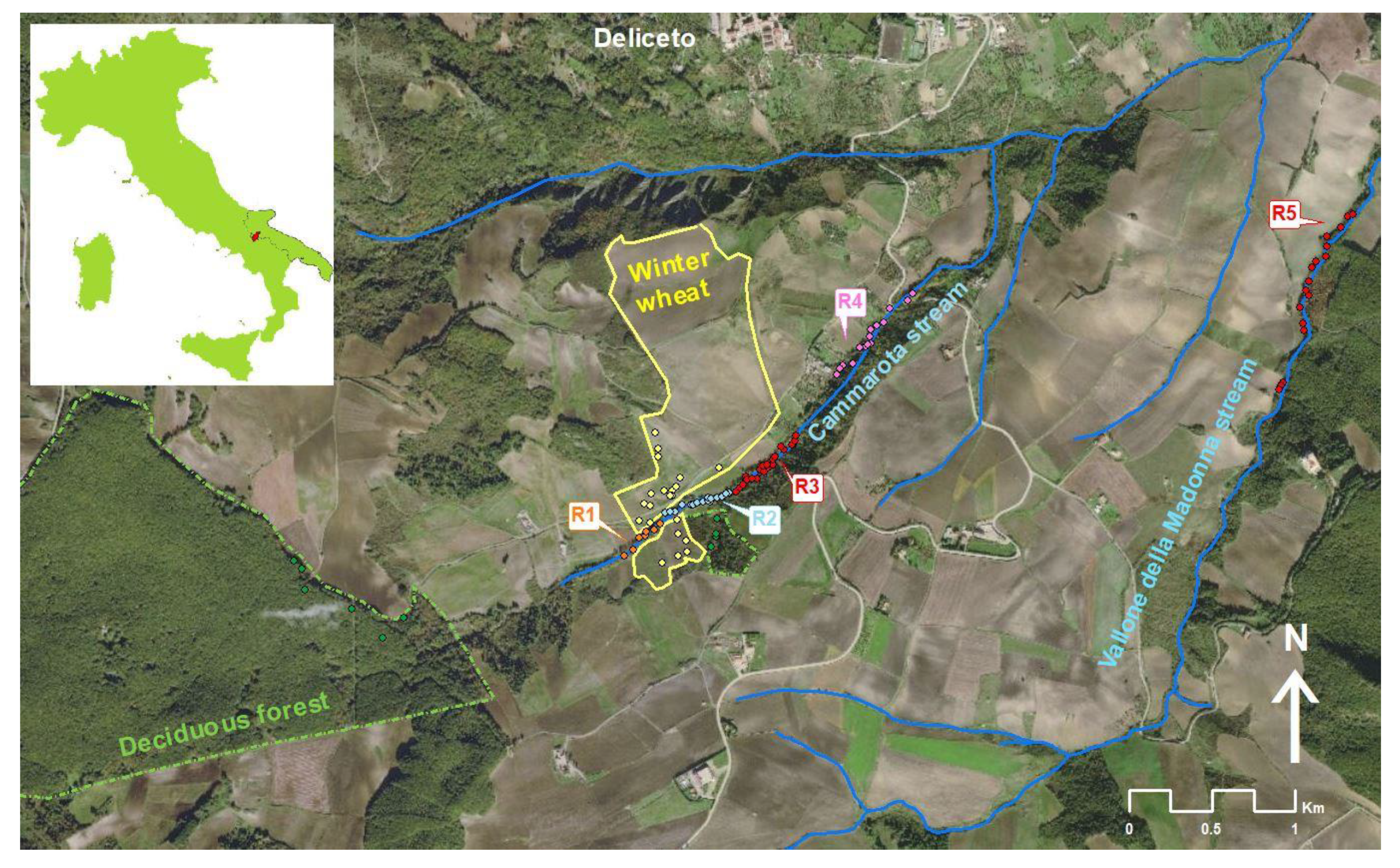
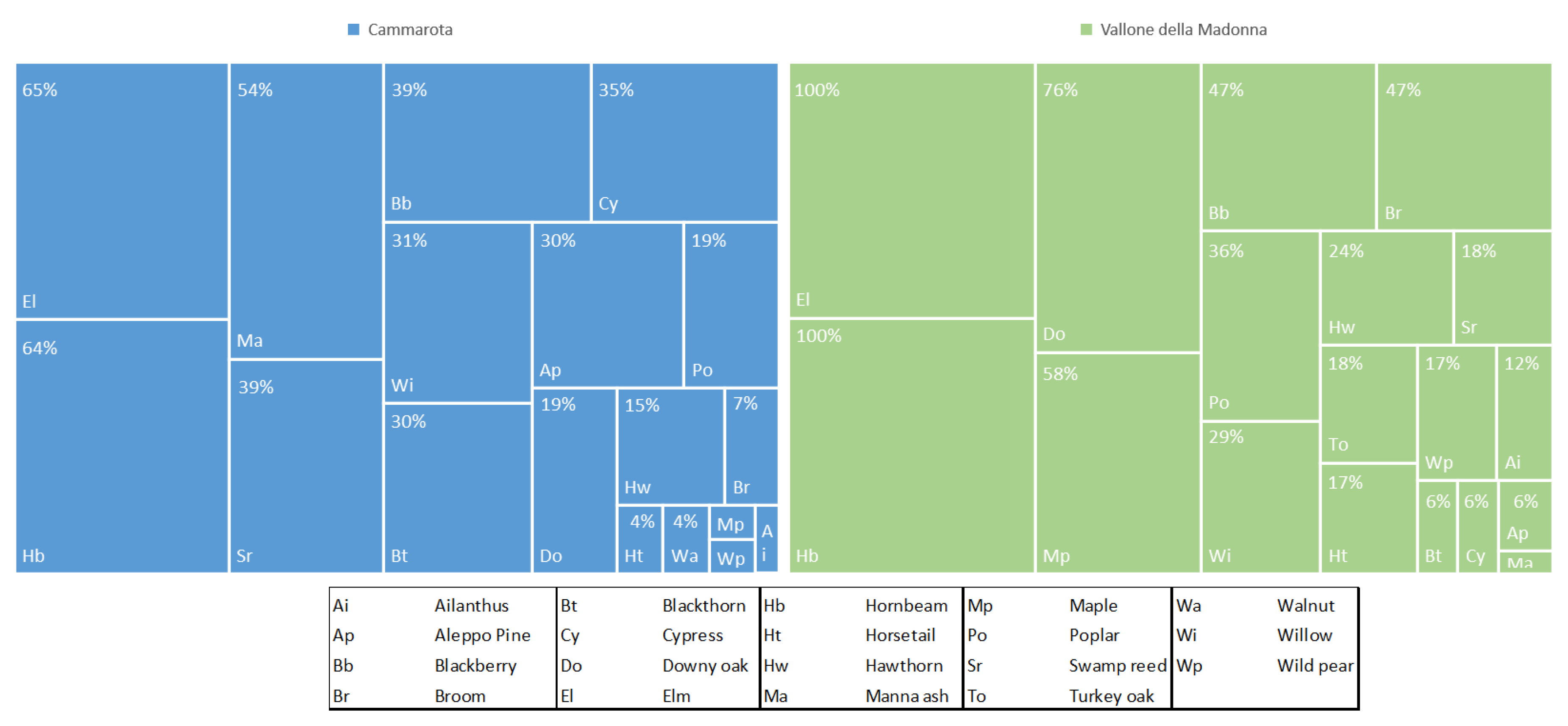

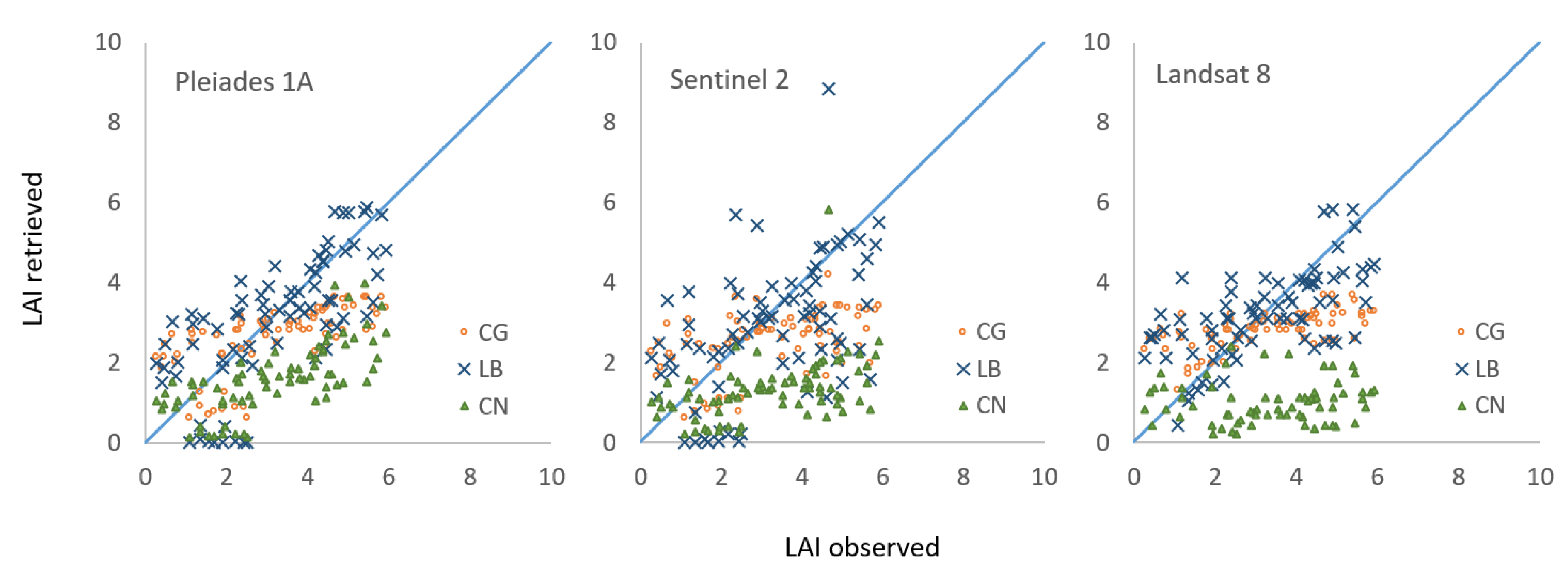
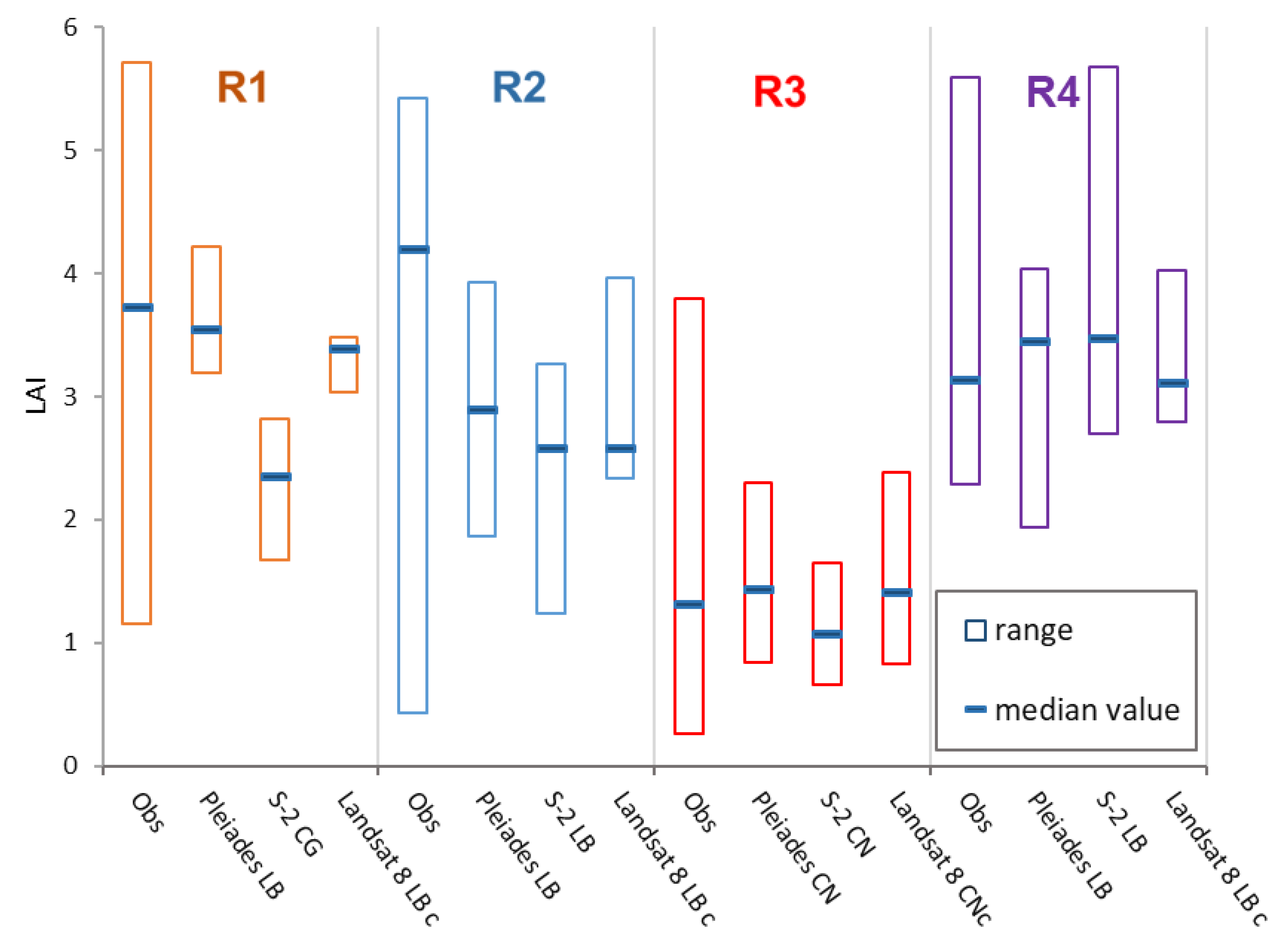
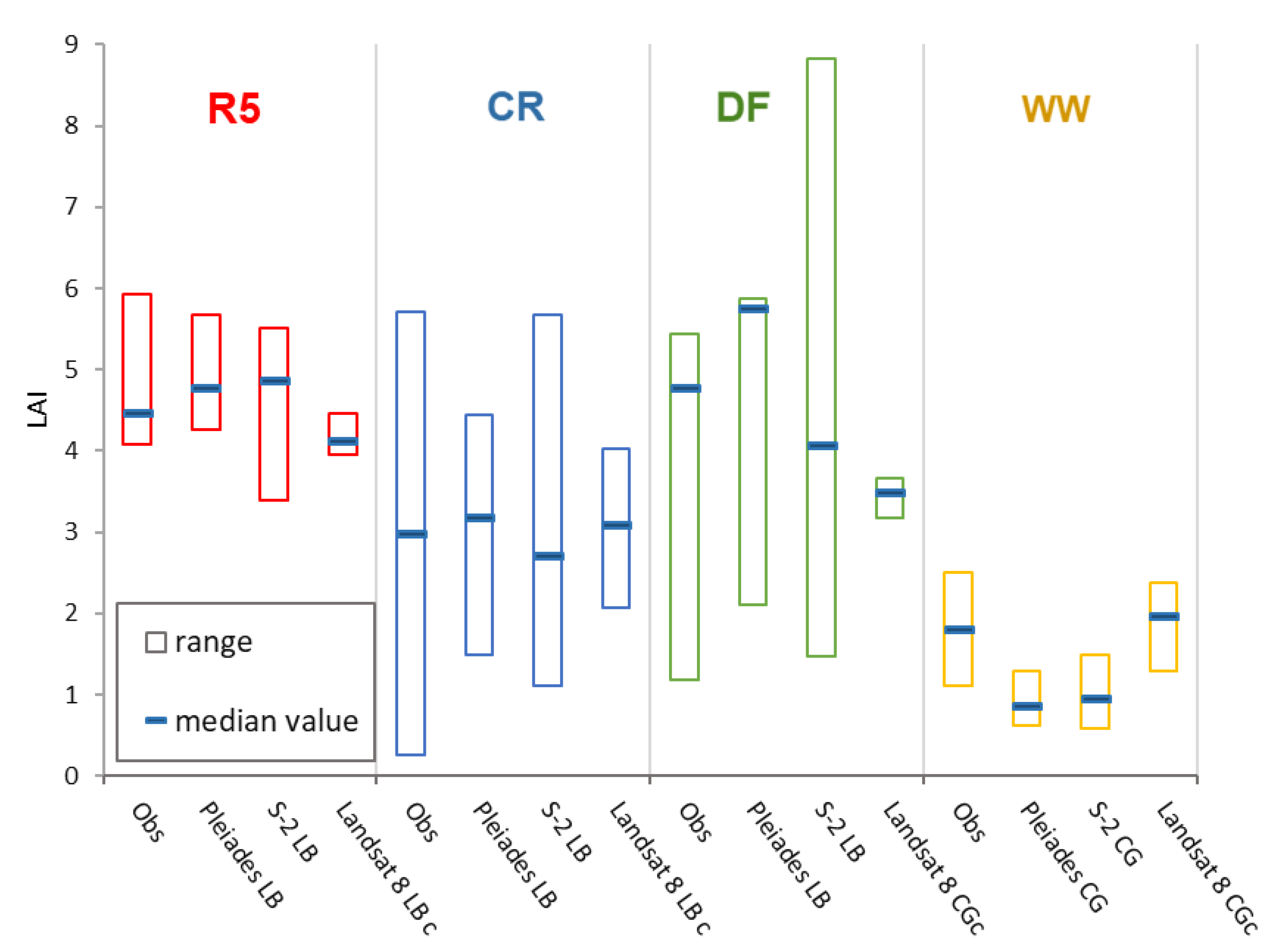
| Reach Name | Erosion | Check Dams | Vegetation |
|---|---|---|---|
| R1-Upstream reach | Absent | Intact or slightly damaged | Stratified in a regular pattern |
| R2-Incipient erosion reach | Riverbed | Damaged or destroyed | From dense to absent |
| R3-Full erosion reach | Riverbed and Banks | Destroyed | Absent |
| R4-Downstream reach | Very low | Slightly damaged and destroyed | Stratified in the riverbed |
| Equation | Algorithm | Source | |
|---|---|---|---|
| Caraux-Garson (CG) | Caraux-Garson et al. [63] | (a) | |
| Lambert-Beer (LB) | Lacaze et al. [64] | (b) | |
| Campbell and Norman (CN) | Walthall et al. [65] | (c) |
| Pleiades-1A | Sentinel-2 | Landsat 8 | ||||||||
|---|---|---|---|---|---|---|---|---|---|---|
| LAI CG | LAI LB | LAI CN | LAI CG | LAI LB | LAI CN | LAI CG | LAI LB | LAI CN | ||
| R1 | PBIAS | 19.52 | 3.21 | 52.62 | 37.09 | 39.45 | 71.81 | 18.45 | 5.55 | 77.65 |
| R2 | 0.44 | 0.40 | 0.36 | 0.36 | 0.37 | 0.37 | 0.80 | 0.79 | 0.78 | |
| NSE | −0.19 | 0.26 | −2.13 | −1.55 | −2.18 | −4.50 | −0.16 | 0.17 | −4.25 | |
| RMSE | 1.39 | 1.10 | 2.26 | 2.04 | 2.28 | 3.00 | 1.43 | 1.21 | 3.04 | |
| R2 | PBIAS | 26.40 | 22.34 | 61.89 | 32.81 | 31.19 | 69.26 | 28.33 | 24.11 | 85.18 |
| R2 | 0.34 | 0.31 | 0.29 | 0.01 | 0.01 | 0.01 | 0.04 | 0.03 | 0.04 | |
| NSE | −0.26 | −0.03 | −2.33 | −0.80 | −0.81 | −3.52 | −0.56 | −0.43 | −5.31 | |
| RMSE | 2.30 | 2.22 | 2.95 | 1.83 | 1.84 | 2.91 | 1.71 | 1.64 | 3.43 | |
| R3 | PBIAS | −67.78 | −80.47 | 9.11 | −63.11 | −70.58 | 23.73 | −77.42 | −91.13 | −1.22 |
| R2 | 0.56 | 0.56 | 0.54 | 0.42 | 0.43 | 0.44 | 0.55 | 0.58 | 0.60 | |
| NSE | −0.55 | −0.80 | 0.38 | −0.48 | −0.64 | 0.17 | −0.97 | −1.22 | 0.51 | |
| RMSE | 1.31 | 1.41 | 0.82 | 1.28 | 1.34 | 0.95 | 1.48 | 1.57 | 0.73 | |
| R4 | PBIAS | 18.39 | 1.95 | 50.91 | 3.27 | −21.45 | 48.62 | 18.90 | 6.40 | 78.08 |
| R2 | 0.18 | 0.24 | 0.34 | 0.04 | 0.04 | 0.05 | 0.78 | 0.78 | 0.79 | |
| NSE | −0.20 | 0.22 | −2.39 | −0.64 | −5.11 | −7.40 | −0.13 | 0.50 | −5.99 | |
| RMSE | 1.21 | 0.98 | 2.04 | 1.28 | 1.49 | 2.27 | 1.17 | 0.78 | 2.93 | |
| R5 | PBIAS | 28.66 | −0.68 | 46.41 | 32.30 | 3.43 | 58.46 | 32.64 | 12.27 | 75.57 |
| R2 | 0.50 | 0.56 | 0.68 | 0.40 | 0.61 | 0.72 | 0.61 | 0.64 | 0.63 | |
| NSE | −4.62 | 0.53 | −12.05 | −5.82 | 0.49 | −19.51 | −6.13 | −0.53 | −33.38 | |
| RMSE | 1.47 | 0.42 | 2.23 | 1.62 | 0.44 | 2.80 | 1.65 | 0.77 | 3.63 | |
| DF | PBIAS | 20.67 | −11.88 | 35.32 | 23.22 | −7.61 | 47.46 | 14.77 | −24.05 | 61.55 |
| R2 | 0.84 | 0.85 | 0.74 | 0.04 | 0.07 | 0.06 | 0.74 | 0.71 | 0.71 | |
| NSE | 0.24 | 0.70 | −0.19 | −0.41 | −1.22 | −2.19 | 0.07 | 0.17 | −2.49 | |
| RMSE | 1.28 | 0.81 | 1.61 | 1.75 | 2.19 | 2.63 | 1.42 | 1.34 | 2.75 | |
| WW | PBIAS | 50.92 | 94.19 | 86.64 | 46.52 | 91.78 | 81.44 | −8.58 | 18.54 | 102.91 |
| R2 | 0.01 | 0.06 | 0.01 | 0.02 | 0.01 | 0.02 | 0.79 | 0.80 | 0.80 | |
| NSE | −4.43 | −14.37 | −11.99 | −3.54 | −13.64 | −10.51 | 0.62 | 0.20 | −16.16 | |
| RMSE | 1.06 | 1.78 | 1.64 | 0.97 | 1.74 | 1.54 | 0.28 | 0.40 | -- | |
Publisher’s Note: MDPI stays neutral with regard to jurisdictional claims in published maps and institutional affiliations. |
© 2020 by the authors. Licensee MDPI, Basel, Switzerland. This article is an open access article distributed under the terms and conditions of the Creative Commons Attribution (CC BY) license (http://creativecommons.org/licenses/by/4.0/).
Share and Cite
Romano, G.; Ricci, G.F.; Gentile, F. Influence of Different Satellite Imagery on the Analysis of Riparian Leaf Density in a Mountain Stream. Remote Sens. 2020, 12, 3376. https://doi.org/10.3390/rs12203376
Romano G, Ricci GF, Gentile F. Influence of Different Satellite Imagery on the Analysis of Riparian Leaf Density in a Mountain Stream. Remote Sensing. 2020; 12(20):3376. https://doi.org/10.3390/rs12203376
Chicago/Turabian StyleRomano, Giovanni, Giovanni Francesco Ricci, and Francesco Gentile. 2020. "Influence of Different Satellite Imagery on the Analysis of Riparian Leaf Density in a Mountain Stream" Remote Sensing 12, no. 20: 3376. https://doi.org/10.3390/rs12203376
APA StyleRomano, G., Ricci, G. F., & Gentile, F. (2020). Influence of Different Satellite Imagery on the Analysis of Riparian Leaf Density in a Mountain Stream. Remote Sensing, 12(20), 3376. https://doi.org/10.3390/rs12203376





